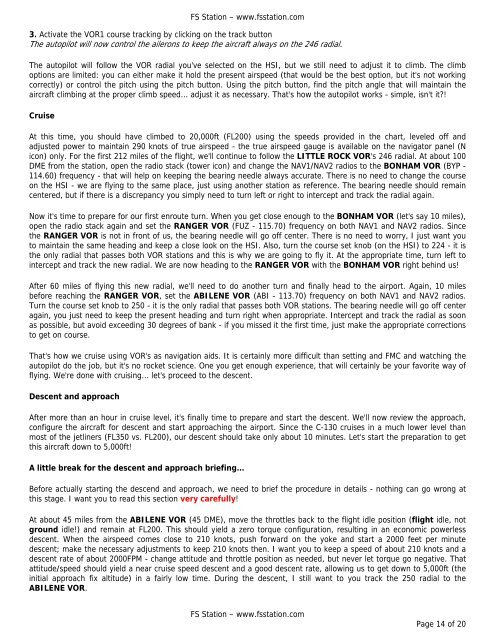Captain Sim 'Legendary C-130' - Flight Tutorial - e-HAF
Captain Sim 'Legendary C-130' - Flight Tutorial - e-HAF
Captain Sim 'Legendary C-130' - Flight Tutorial - e-HAF
You also want an ePaper? Increase the reach of your titles
YUMPU automatically turns print PDFs into web optimized ePapers that Google loves.
FS Station – www.fsstation.com3. Activate the VOR1 course tracking by clicking on the track buttonThe autopilot will now control the ailerons to keep the aircraft always on the 246 radial.The autopilot will follow the VOR radial you've selected on the HSI, but we still need to adjust it to climb. The climboptions are limited: you can either make it hold the present airspeed (that would be the best option, but it's not workingcorrectly) or control the pitch using the pitch button. Using the pitch button, find the pitch angle that will maintain theaircraft climbing at the proper climb speed... adjust it as necessary. That's how the autopilot works - simple, isn't it?!CruiseAt this time, you should have climbed to 20,000ft (FL200) using the speeds provided in the chart, leveled off andadjusted power to maintain 290 knots of true airspeed - the true airspeed gauge is available on the navigator panel (Nicon) only. For the first 212 miles of the flight, we'll continue to follow the LITTLE ROCK VOR's 246 radial. At about 100DME from the station, open the radio stack (tower icon) and change the NAV1/NAV2 radios to the BONHAM VOR (BYP -114.60) frequency - that will help on keeping the bearing needle always accurate. There is no need to change the courseon the HSI - we are flying to the same place, just using another station as reference. The bearing needle should remaincentered, but if there is a discrepancy you simply need to turn left or right to intercept and track the radial again.Now it's time to prepare for our first enroute turn. When you get close enough to the BONHAM VOR (let's say 10 miles),open the radio stack again and set the RANGER VOR (FUZ - 115.70) frequency on both NAV1 and NAV2 radios. Sincethe RANGER VOR is not in front of us, the bearing needle will go off center. There is no need to worry, I just want youto maintain the same heading and keep a close look on the HSI. Also, turn the course set knob (on the HSI) to 224 - it isthe only radial that passes both VOR stations and this is why we are going to fly it. At the appropriate time, turn left tointercept and track the new radial. We are now heading to the RANGER VOR with the BONHAM VOR right behind us!After 60 miles of flying this new radial, we'll need to do another turn and finally head to the airport. Again, 10 milesbefore reaching the RANGER VOR, set the ABILENE VOR (ABI - 113.70) frequency on both NAV1 and NAV2 radios.Turn the course set knob to 250 - it is the only radial that passes both VOR stations. The bearing needle will go off centeragain, you just need to keep the present heading and turn right when appropriate. Intercept and track the radial as soonas possible, but avoid exceeding 30 degrees of bank - if you missed it the first time, just make the appropriate correctionsto get on course.That's how we cruise using VOR's as navigation aids. It is certainly more difficult than setting and FMC and watching theautopilot do the job, but it's no rocket science. One you get enough experience, that will certainly be your favorite way offlying. We're done with cruising... let's proceed to the descent.Descent and approachAfter more than an hour in cruise level, it's finally time to prepare and start the descent. We'll now review the approach,configure the aircraft for descent and start approaching the airport. Since the C-130 cruises in a much lower level thanmost of the jetliners (FL350 vs. FL200), our descent should take only about 10 minutes. Let's start the preparation to getthis aircraft down to 5,000ft!A little break for the descent and approach briefing...Before actually starting the descend and approach, we need to brief the procedure in details - nothing can go wrong atthis stage. I want you to read this section very carefully!At about 45 miles from the ABILENE VOR (45 DME), move the throttles back to the flight idle position (flight idle, notground idle!) and remain at FL200. This should yield a zero torque configuration, resulting in an economic powerlessdescent. When the airspeed comes close to 210 knots, push forward on the yoke and start a 2000 feet per minutedescent; make the necessary adjustments to keep 210 knots then. I want you to keep a speed of about 210 knots and adescent rate of about 2000FPM - change attitude and throttle position as needed, but never let torque go negative. Thatattitude/speed should yield a near cruise speed descent and a good descent rate, allowing us to get down to 5,000ft (theinitial approach fix altitude) in a fairly low time. During the descent, I still want to you track the 250 radial to theABILENE VOR.FS Station – www.fsstation.comPage 14 of 20
















